|
|
| Interlacing floral scrolls with Sanskrit characters. It shows typical calligraphic style of execution of the motif |
Overview of Folk Kiln (Minyao) Ming Blue and White
Early Ming Period [Hungwu (洪武) to Tianshun (天顺), 1368 To 1464 ]
During the early Ming period, the court imposed a relatively high degree of control on political and cultural development. For e.g.. during the reign of Hongwu, a decree was issued in the year 1371 which forbid certain subjects such as previous emperors, queens, sages or saints, dragon, phoenix, lion and chilin on porcelains. Another instance was the decree issued in the year 1447 by emperor Zhengtong (正统) which prohibited the production of colour glaze such as yellow, purple, red or blue glazes including those with under glazed blue design.
Such restrictions significantly impacted the type of decorations found on folk kiln blue and white wares. Only a relatively limited range of motifs were available. Usually the motifs are highly stylised and simplified and executed in calligraphic style. It was dictated by economic considerations as such mode of production facilitated quick execution and increased production volume. The calligraphic lines of the motif is spontaneous and highly rhythmic. This carefree style without depiction of details has a charm and character of its own.
Recent scientific tests seem to indicate that Yuan blue and white used solely imported cobalt. During the reign of Hongwu, he issued decrees prohibiting foreign contact and trade. Hence, the source of imported cobalt would have been cut off. It is likely that remaining imported cobalt during the period were used for imperial blue and white. Hence, very few, if any, folk kiln blue and white had been produced during Hongwu or even Yongle (永乐) period. This is not far-fetched. For those Hongwu imperial blue and white, we can still see stylistic continuity from the Yuan period. However, for motifs on folk kiln blue and white attributed to Hongwu, they generally lack stylistic similarity to those from Yuan period. This logically should not be the case in the evolvement of artistic styles. Another issue which need to be explored is when the potters started using local cobalt if only imported cobalt was used during the Yuan period. For more discussion, please read : Early Ming Folk kiln blue and white revisit.
During the early Ming period, the typical motifs depicted included: interlacing floral scroll with Sanskrit character , rolling clouds, 3 friends of winter (represented by pine, plum and bamboo), ornamental balls with silk knots, characters fu (福) (fortune) and shou (寿) (longevity), rolling clouds with human figures which resemble dreamland and hermit in countryside setting. The influence of Tibetan Buddhism is shown in elements such as Sanskrit/Tibetan characters and Buddhist 8 precious objects (conch shell, wheel, umbrella, canopy, lotus, vase, fish, endless knot).
|
|
| Interlacing floral scrolls with Sanskrit characters. It shows typical calligraphic style of execution of the motif |
Cloud motif

rolling clouds with human figures

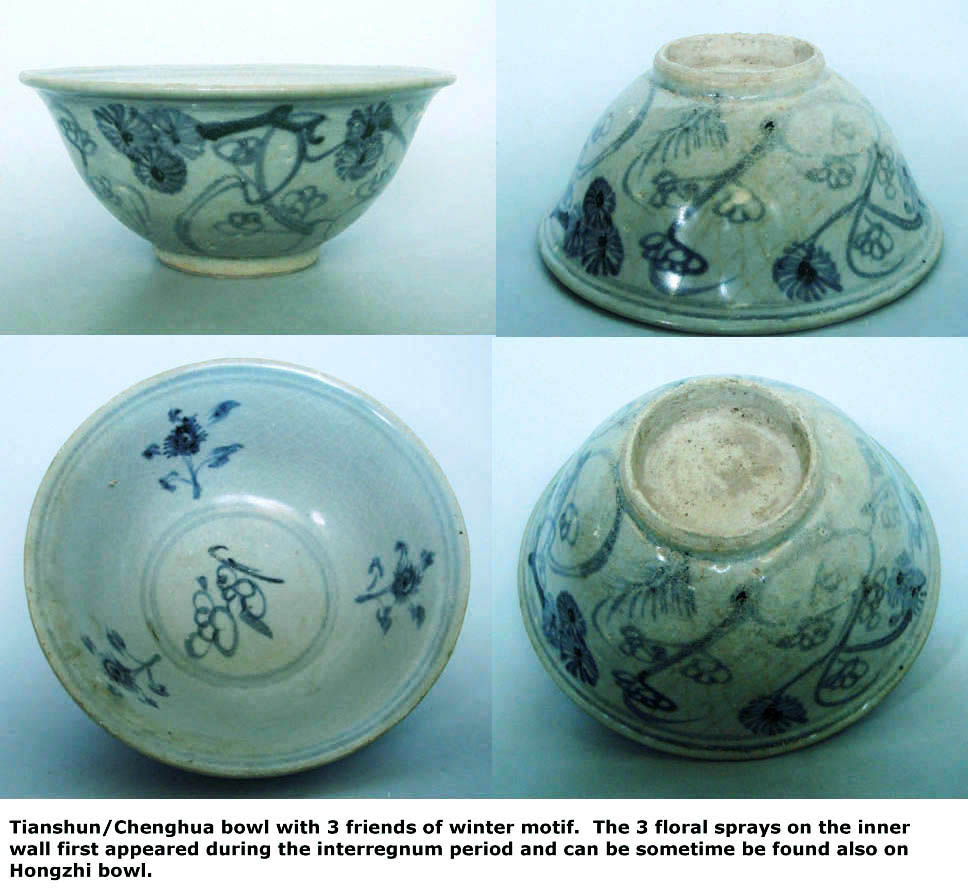
Majority of the wares produced during the Early Ming period were functional in nature, such as bowl, plate, covered jar and incense burner. Vases only constituted a small quantity of the production.
In 1964, Wang Zhimin (王志敏) of Nanjing museum pioneered a project on identification of early Ming blue and white. He collected tens of thousands ceramic shards from the Yudai river where the old Nanjing palace was located. Based on stylistic comparison, he was able to form some meaningful deductions on characteristics associated with each dynastic Ming period. With the guidelines formulated, one could more confidently separate Xuande (宣德) or earlier blue and white from those dated to the Interregnum period [Zhengtong (正统), Jingtai (景泰) and Tianshun (天顺), with a duration of 29 years spanning 1436 to 1465].
To a significant extent, his findings was a big step forward for the study of Ming folk kilns blue and white. But there is still the difficulty in determining the end-date for a particular style of motif. It is not unjustifiable to assume a transitional phase during which an old style and an emerging new style co-existed. The old style will ultimately be abandoned but there is still difficulty in determining the end point of a particular style.
Two examples illustrate this problem. The calligraphic chilin and lion plates are known to have been produced during the Xuande/Interregnum period. A small quantity of Chinese ceramics including some dishes with the chilin motif, were salvaged from the Pandanan shipwreck in Philippines and dated to the Interregnum period. However, the Lena shoal junk (found near the Lena Shoal of Busuanga Island in the Philippines in 1997) with its well preserved cargo of typical Hongzhi blue and white wares, sprung up a few surprises. There were a number of chilin plates and some bowls with abstract cloud and floral motifs executed in calligraphic style usually attributed to Early Ming Interregnum period.
The second case concerned a Guangdong Dongguan family graveyard of Zhong Songxue. The earliest burial was in second year of Zhengde . Five jars with typical Hongzhi style scholar in garden setting were found. in the adjacent burial site of one of Zhong Songxue's son, two big late Zhengde/early Jiajing jars, one with floral and the other with fish motif were recovered. Also found together was a lion plate and a bowl executed in interregnum period calligraphic style. Based on the Dongguan chronicle, one of Zhong Songxue's sons died in the 7th year of Jiajing.
 |
 |
| Similar Qilin plate found in Lena and Pandanan wreck. This one is most probably dated to Hongzhi period. Those from the Interregnum period are better drawn especially the cloud' | Plate with lion motif are mostly from the Chenghua/Hongzhi period. Some were found after Hongzhi period but the drawing appears more sketchy and poorly drawn. |
During the interregnum period there were numerous laws restricting or banning production of blue and white wares. Coupled with a declining tribute system of trade and ban on illegal private trade, the amount of porcelain that reached the overseas market would have been small. This appears to have been the case based on shipwrecks findings. So far, shipwrecks, such as Pandanan and the Royal Nanhai wreck in South China sea, which are dated to Interregnum period carried only small quantity of Chinese ceramics. However by the Hongzhi period, a thriving illegal private trade has developed. The Hongzhi period Lina cargo is clear reflection of the situation. It carried a relatively large quantity of good quality blue and white wares. Another contributing factor which prompted this development was the situation during the Hongzhi period. During the reign of Chenghua, the imperial kiln produced large quantity of porcelains as can be seen from the excavations in Jingdezhen. When Hongzhi took over, he recognised that it was a big drain on the state finance. He ordered imperial porcelain production to be drastically reduced. As a result, the redundant potters would have to find other means to support their livelihood. They turned to production of wares to meet oversea demand.
A significant volume of blue and white excavated in Southeast Asia were usually attributed to the interregnum period. The political situation in China highlighted above suggested that the dating could be wrong. They may have been produced later, most probably during the Chenghua to Hongzhi period instead.
Almost all the known folk kiln sites in Jingdezhen region were badly disturbed and destroyed. Hence, scientific excavation is almost impossible. Currently, a good source for dating is artefacts recovered from datable tombs. Regrettably, the information is limited and not widely circulated. Such excavation information together with those from shipwrecks will enable more detailed studies and accurate dating. We will also be able to ascertain how a particular motif evolved over time and the duration which a particular style of the motif persisted. Hopefully, we can also better identify the minor stylistic changes associated with a style as they evolved over time. It is a worthwhile project but it would require patience and co-operation from different sources to build up a comprehensive database.
Mid Ming Period (Chenghua (成化) to Zhengde (正德), 1465 to 1521)
By the Mid Ming period , production and demands for porcelain increased considerably due to demand from illegal private trade. Officially the tribute system of foreign trade implemented since Hongwu period only came to an end in 1567 (Jiajing) with the opening of Yuegang (月港) in Fujian for legal foreign trade. The tribute system of trade reached its peak during the Yongle/Xuande period epitomised by Admiral Zhenghe's trips on large fleet of treasure ships which reached as far as East coast of Africa. Subsequently, the tribute system could not be implemented effectively after the decline of the power of the empire. Some contributing factors included internal problem such as the capture of Zhengtong (正统) emperor by the Mongols and official corruption. To meet overseas demand, illegal foreign trade became increasingly more prevalent. By the Chenghua period, the 3 coastal province of Zhejiang, Fujian and Guongdong had flourishing private trade. Such illicit arrangement involved powerful rich families and facilitated by tacit assistance of corrupt provincial officials.
The pigmented-wash method of decoration which was experimented most probably during the Tianshun period gained greater popularity and used on bulk of the blue and white wares from late Chenghua onward. The wash was applied over some part of the drawn motif such as the flower or dress of human figure. Generally you can distinguish two tonal blue in the wash area Most actually utilised a combination of calligraphic and pigmented-wash method to execute the motif. Those that utilised fully calligraphic style or with motif completely cover with pigment wash constitute a smaller portion of the production.
|
|
|
|
The
above ink grinder is dated to 9th year of Hongzhi period. The
flower is completed using the pigmented wash while the leaves still used
the typical calligraphic strokes
|
|
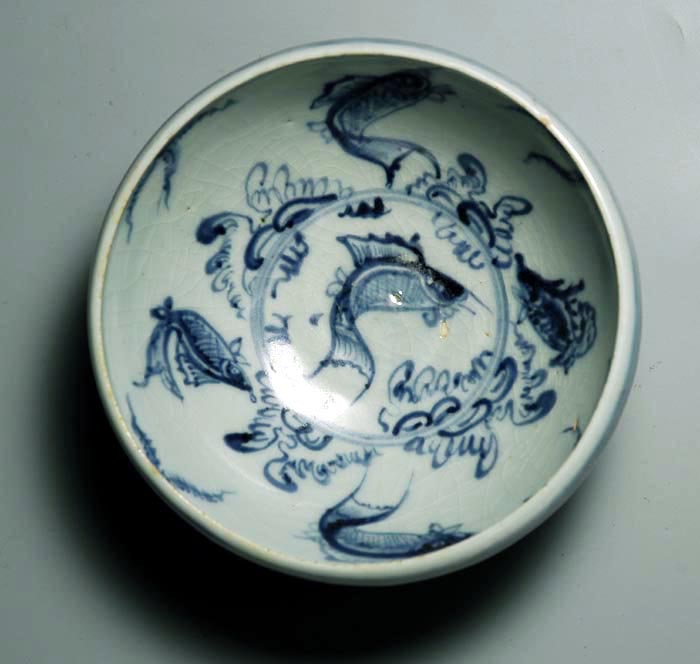 |
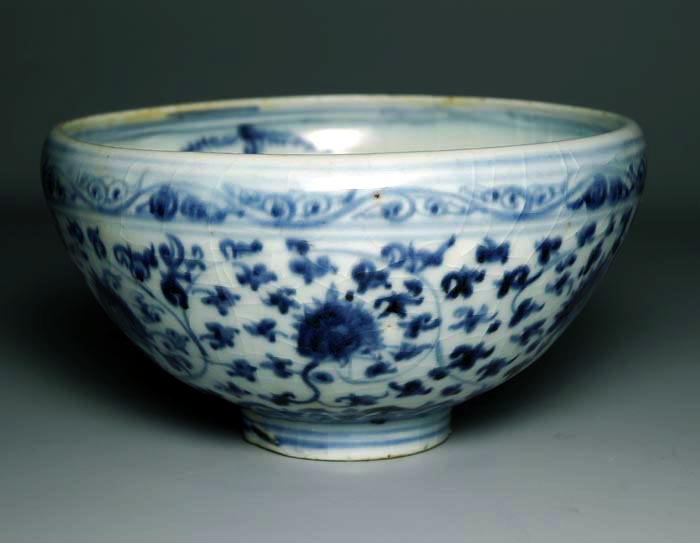 |
| Hongzhi warmer bowl | |
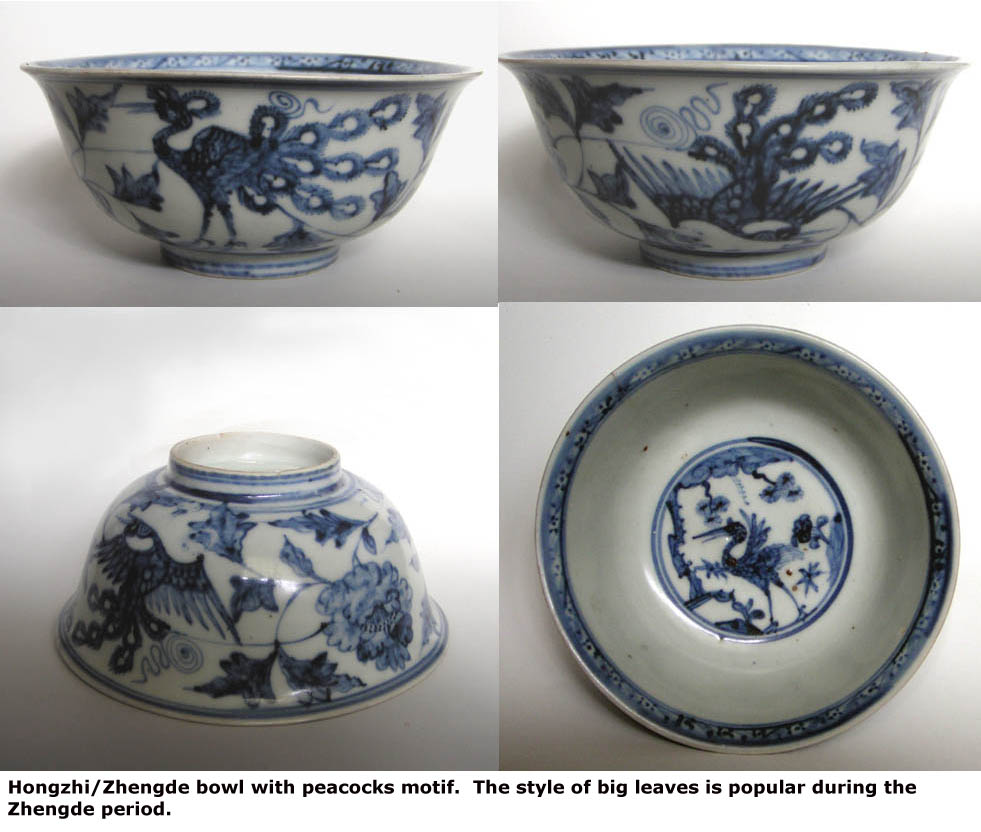
Example showing motif completely covered with wash of blue
The Lena cargo is a very interesting and important find. The varied styles of motif indicated that Hongzhi is a watershed period. The majority can be positively identified with the Chenghua/Hongzhi period. There is a small number with typical interregnum calligraphic style. It indicated the dying interest in the style. Lastly, there was a small number such as the floral scrolls with Buddhist precious objects and lingzhi fungus scrolls, which shows emerging elements typical of Jiajing period.
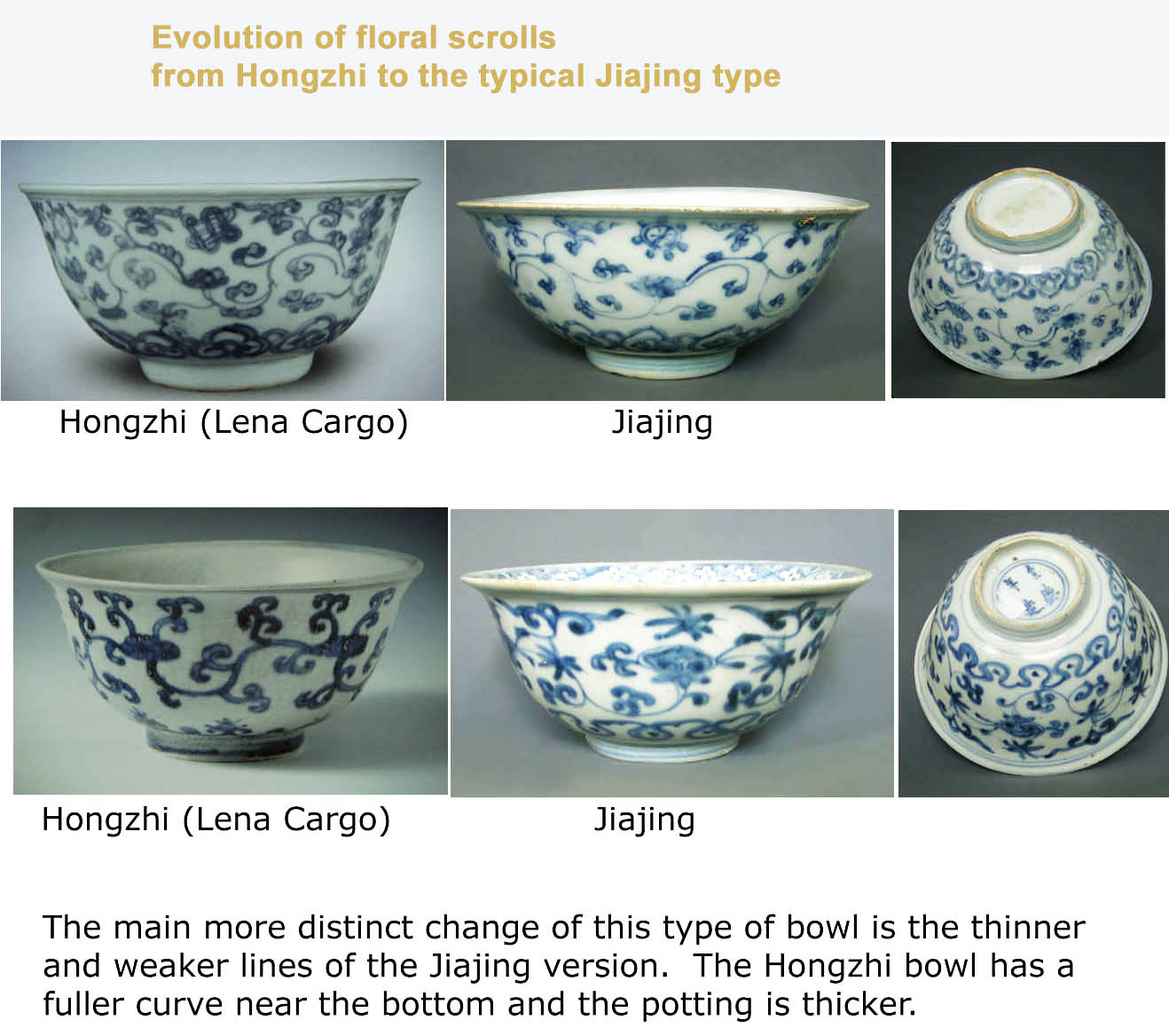
During the Zhengde period, some blue and white porcelains with Islamic influence such as Arabic scripts were produced. Some speculated that it was because emperor Zhengde was converted to Muslim faith. However, the more probable reason could be the influence of the powerful eunuchs , many of whom were Muslims.
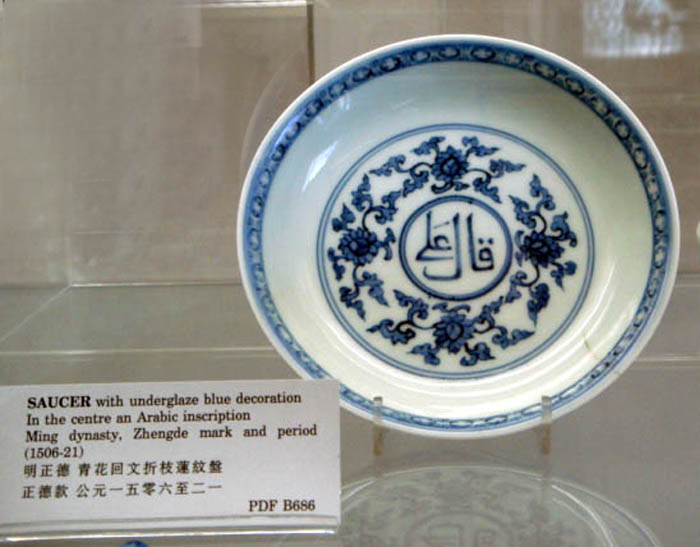
Ming Hongzhi period also witnessed a change in the design composition. Many bowls and plates have more densely and fully decorated inner wall. This is a rather unique phase as those before and after this period generally have plain or more sparsely decorated inner wall. The exception was the kraak style motifs of Wanli/Chongzhen period.
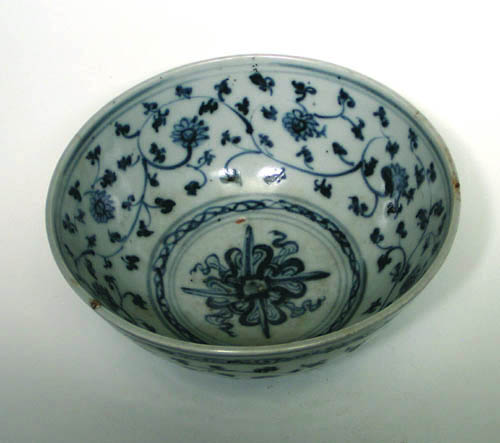 |
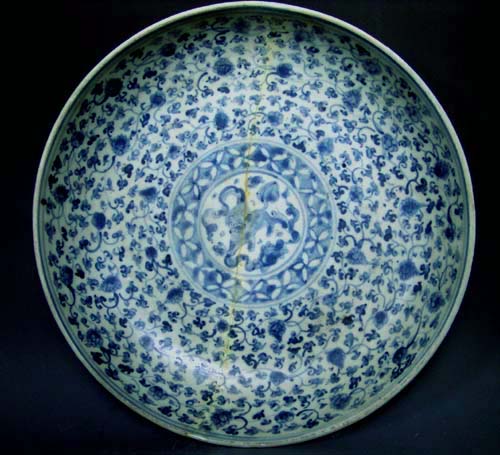 |
| More densely decorated interior of bowls and plates | |
Mark such as "Fu (福)" , "Da Ming Nianzao (大明年造)", "Tian (天)" and "Tai ping (太平)" , on the outer base also appeared in wares during Chenghua/Hongzhi period.
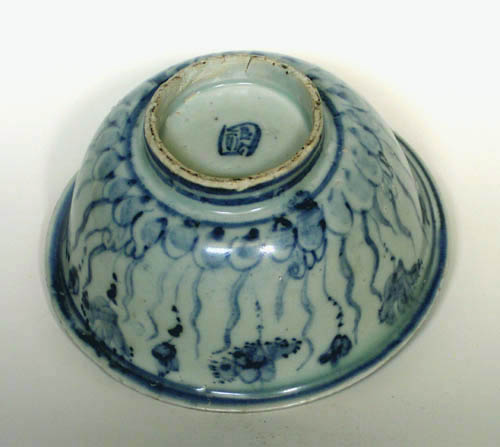
Bowl with fu mark on outer base
Late Ming Period (Jiajing (嘉靖) to Chongzhen (崇祯), 1522 to 1644)
Jiajing period heralded the implementation of the Guan da min shao (官搭民烧) system. Under this system, imperial porcelain production was contracted out to private kiln operators. The high quality requirement forced the potters to improve quality of their products. The penalty for failure to meet quantity and quality requirements was stiff. Besides paying a fine, they had to buy in pieces from the officials to meet any shortfall in government order.
Emperor Jiajing who succeeded Zhengde was a devout Taoist. Taoist symbolism became a common decorative element during the late Ming period. Taoist motifs such as the Eight immortals, eight Taoist Emblems, the Pakua (eight diagrams) , the cranes, auspicious character shou (often formed by twisted peach tree as above picture) were frequently used.
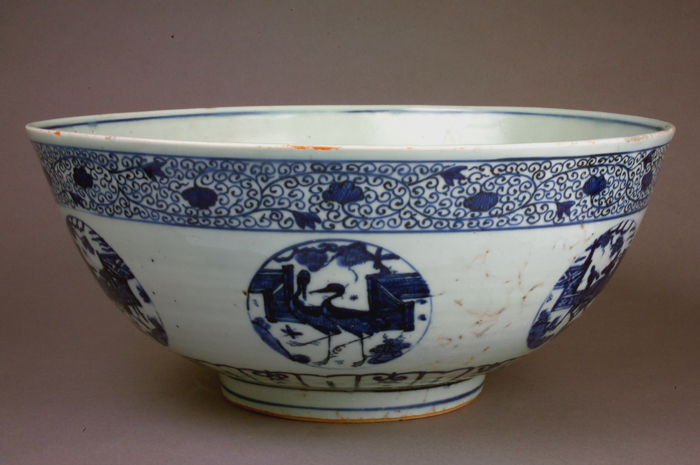 |
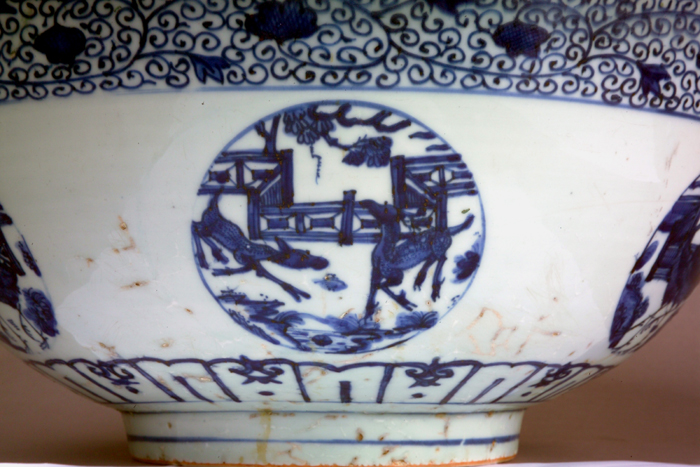 |
 |
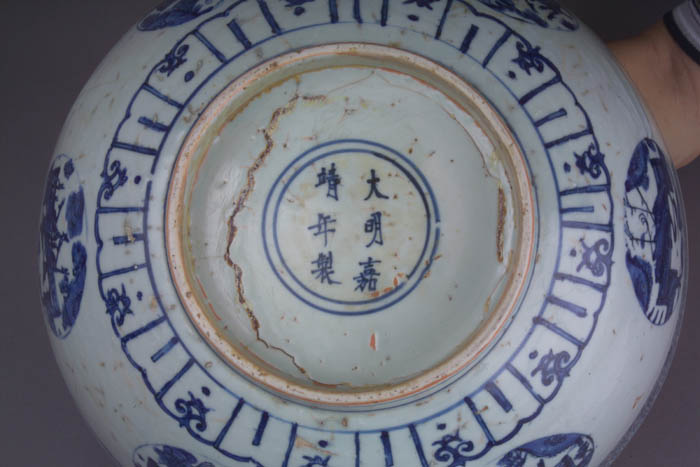 |
| Jiajing bowl with crane's and deer's motif. They are all Taoist symbols of longevity | |
. 
Jiajing jar with floral scrolls and Taoist 8 diagrams
A
unique feature for Jiajing/wanli period is the use of Hui qing (回青)
, a form of imported cobalt which is purplish in colour tone. Hui
qing needs to be mixed with local cobalt as too high an amount of it will
conceal the details of the lines under the wash. A well proportioned
mixture of hui-qing and local cobalt will create a brilliant clear purplish
motif. From Jiajing onward, the outline and wash method became the
mainstream style of decoration. The outline is thin and of even thickness,
which the Chinese calls iron thread. The good quality pieces also have
clear even one tone wash.
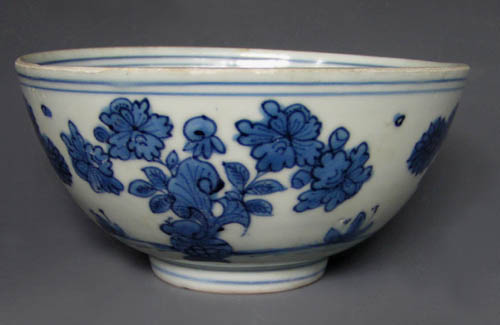
|
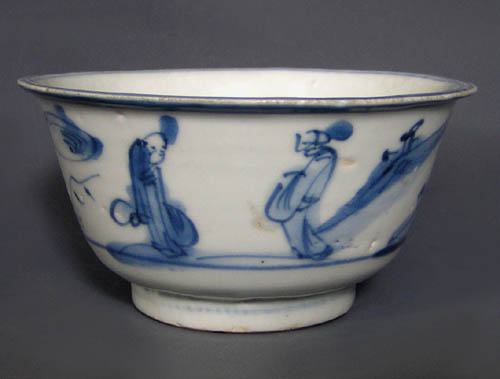 |
| A typical late Jiajing/early wanli bowl with outline and wash floral motif. It also has the purplish tone of Hui qing. | Tianqi bowl which shown the initial phase of shading of the rock which became a typical feature on Qing Kangxi pieces. |
 |
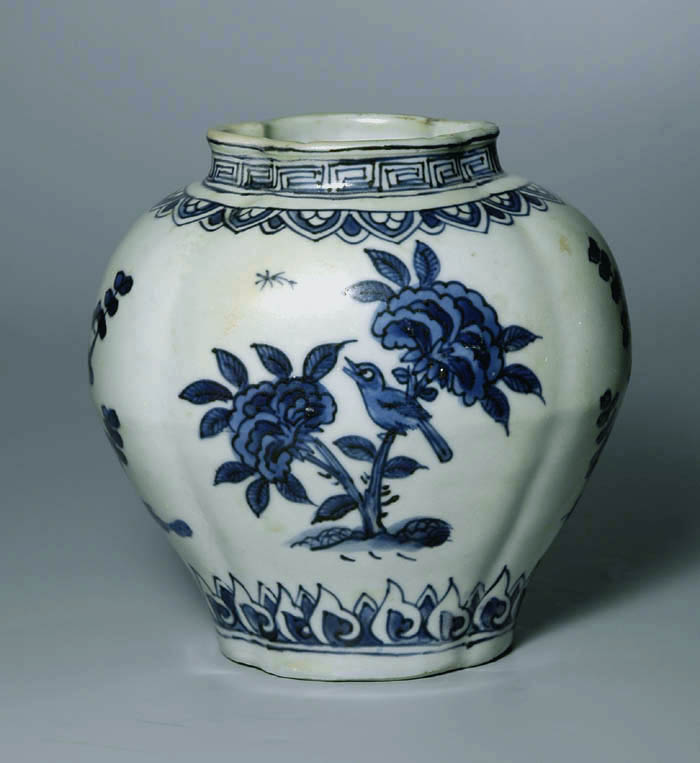 |
| Wanli bowl with infants motif | Jiajing/Wanli jar with bird/floral motif |
Many of the Jiajing/Tianqi bowls/plates also carried auspicious phrase consisting of 4 Chinese characters on the outer base. Some common phrases include Wan Fu you tong (万福攸同), Fu gui Jiaqing (富贵佳器), Chang Ming Fugui (长命富贵) and etc.
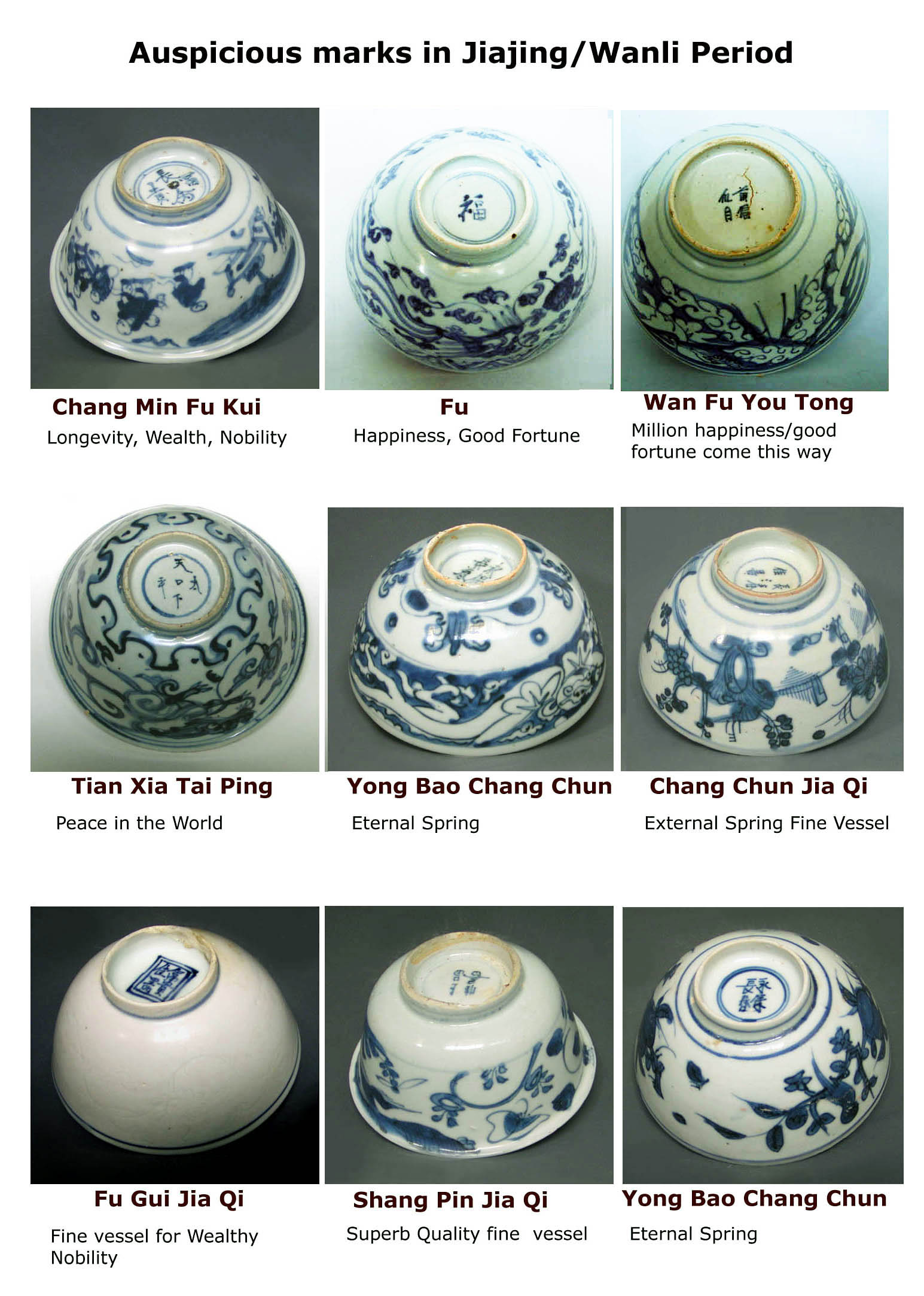
The Jiajing period also saw the emergence of blue and white wares manufactured in Zhangzhou region. This category of wares was termed Swatow wares in the past. It is usually associated with wares with grits adhering to the foot ring and outer base. For a more detailed discussion, please view the article: A general survey of Zhangzhou (Swatow) wares.
The Portuguese maritime explorers made their way to China around 1514. The high quality of the Chinese porcelains generated great interest and demand from the European elite class and the wares became a form of status symbol. Some of the earliest typical blue and white wares exported to Europe are similar to those found in the Fort Sebastian Wreck. A unique form of wares termed the kraak wares made to meet the specifications of European clients were produced from the Wanli period. Kraak derived from "carrack", a type of Portuguese ship captured by the Dutch in 1603 inside which carried a large quantities of these wares. The typical Kraak ware has a central theme on the inside of a bowl or plate and panelled motifs on the interior walls. The walls of the bowls and plates are generally thin. One common defect of the kraak wares is flaking of the glaze along the rim. The Japanese called it mushikui, i.e.. "insect nibbles". Some examples of Wanli kraak wares could be seen in the San Diego Shipwreck.
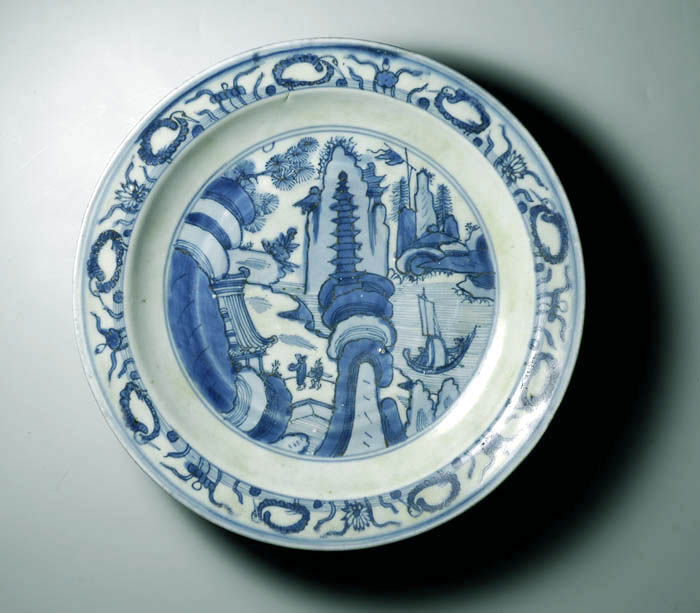
Jiajing/Wanli Kraak style plate

Wanli Kraak ware
During the Chongzhen period, a type of porcelain, commonly called transitional wares were produced. One common feature of these wares is the thick construction. The quality of the porcelain is comparable to those found on imperial wares. The glaze is excellent and the standard of blue and white painting is superb. The subjects covered are varied: including flowers, landscapes and scenes taken from Chinese plays or historical episodes. Many of the pieces also incorporated supplementary foreign decoration, such as the tulip. Also commonly found is a band of incised pattern near the rim of the ware such as incense burners, brush pots, and sleeve vases. The fish scale-like representation of grasses, the curling shaded clouds and mountains/stones with fine shadings were common features during Chongzhen period.
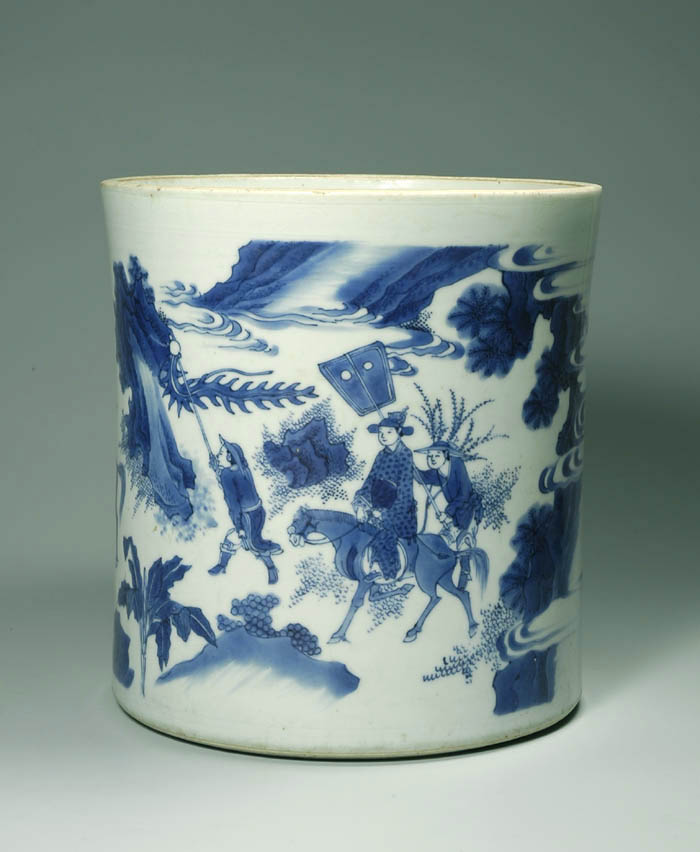
Chongzhen brush pot with fish scale grasses and fine shading of the rocks

Chongzhen vase with tulip motif on the neck
SELECTION OF MY MING BOWL COLLECTION
|
Written by : NK Koh ( 25 Sep 2008), updated (2 Jun 2010)